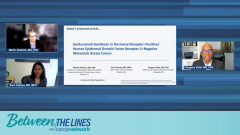
TROPiCS-02: PFS Subgroup Analysis, Summary of Response Rates, and AEs
Drs Dietrich, Tolaney, and Vidal comment on PFS subgroup analyses, response rates, and common adverse events (AEs) observed in the TROPiCS-02 trial.
Episodes in this series

Dr. Sara Tolaney: This was the subgroup analysis looking at people who had early relapse compared to not. Again, you're seeing that Sacituzumab is outperforming chemotherapy irrespective of that, but you do see that the early relapsers do a lot better with Sacituzumab in terms of the difference compared to chemo. I guess it's not too surprising that we know chemotherapy's probably not going to work at an early relapser since there's someone who's clearly demonstrated that resistance, but just goes to show maybe in that particular setting, moving it up earlier is going to be really important. This is just data about response rates. Here, you can see the response rate for Sacituzumab 21% compared to 14% for [00:24:00] chemotherapy so higher, but again, these are such pretreated patients that you're not seeing super high response rates in either arm. I think Martin, you mentioned the fact about when you're making chemotherapy decisions with sequencing, obviously, you're always trying to weigh treatment selection with potential toxicities. What are your thoughts about the toxicity profile of Sacituzumab in terms of common things that you see with it and how you feel like your patients tolerate it?
Dr. Martin Dietrich: Well, I do think that a lot of the side effects that are really clinically concerning to me are actually well supportable. I think that the neutropenia, obviously when we use the Sacituzumab we utilize it ubiquitously with growth factors. I think the percentages are high enough. I think one of the concerning points is the rate of alopecia. I think that's one that needs to be discussed, but at that stage, I believe there's not really a lot of options to not maintain it. I think this is within the frame of expectations of what I would see. I say higher efficacy here comes with a higher level of toxicity. We do see the GI side effects as another area of challenge. Fortunately, most of them are lower grades but there certainly is an understanding that has to be had that the micro environmental effect that Greg was alluding to earlier also comes with off-target effects and collateral damage in the hematopoietic system, in the gastrointestinal system, and then also important in this patient population in manifestation of alopecia. Certainly, a drug that does require a meaningful amount of supportive care for usage in this later-line setting.
Dr. Sara Tolaney: I think you hit the high points. In terms of side effects, I agree that the neutropenia is probably one of the most common things we see. I do tend to use growth factors support when someone presents with neutropenia. Certainly, I think mostly low-grade intermittent diarrhea and really uniform alopecia if someone has hair. Everyone in truths does lose their hair. There is work ongoing to see if scalp cooling may mitigate that toxicity but we need to await those data. Gregory, I think one question that I've often had and I've noticed people practice a little differently is how do you actually utilize growth factor here? For example, in most of the trials, about 50% of people end up needing growth factor support. Are you someone who starts off with growth factor right away when you prescribe Sacituzumab or are you someone who kind of sees how they do with the neutropenia and then introduce it if needed?
Dr. Gregory Vidal: We've gone through some different iteration at our center when it was first approved, just because of the high neutropenia. We actually built in new laster into the care plan and we got a whole bunch of denials on peer-to-peer. We since then took it out and we're more reactive now about [00:27:00] the addition, which I'm very curious whether or not we could actually reduce neutropenia if we start off prophylactically giving it up front. Would love to see that data. My biggest issue with the neutropenia usually is the ones that we see between day 1 and day 8 because you can always give new laster at day 8 because there's two weeks in between. Between the day 1 and day 8 having to come in every day for Neupogen or Neupogen-like is that area that is I think a little bit more time-consuming for patients. I know there are some studies looking at, for example, Trilaciclib during therapeutic as a study that's looking like if we use Trilaciclib upfront, whether or not we could reduce neutropenia. That would be very interesting. I think they're seeing that it's probably effective in that space but again, I dose-reduced so I would love to maintain patients on study, but if I can't, especially between that day 1 and day 8 maintain, and now I often have some dose reductions. New laster at day 8, I'm finding most of my patients are requiring that.
Dr. Sara Tolaney: It's interesting. I also find the growth factor sort of irritating because of the need to do GCSF after day 1. I usually do three or four days and then do the long-acting new laster after day 8. I often I'm able to somehow- sometimes insurance will allow that patient to do it at home. After day 1, it's just a lot. You can't get that.
Dr. Gregory Vidal: They deny me all the time for home. When I lived in California, we got that. When I came to Tennessee, no way.
Dr. Sara Tolaney: It just goes to show how challenging it is at all different centers handling the growth factor with the day-1-day-8 schedule.
Newsletter
Stay up to date on recent advances in the multidisciplinary approach to cancer.



















































































